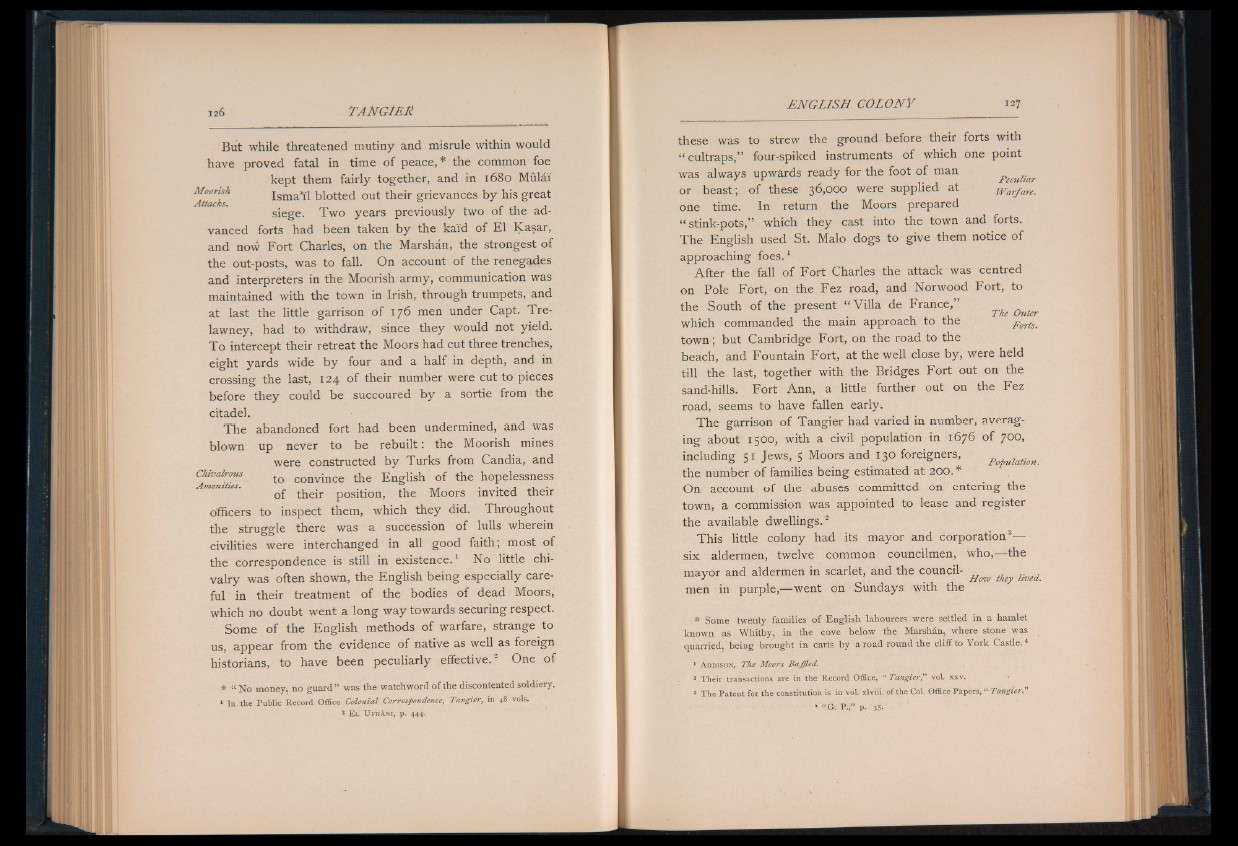
But while threatened mutiny and misrule within would
have proved fatal in time of peace,* the common foe
kept them fairly together, and in 1680 Mulai
Moortsk Isma'i'l blotted out their grievances by his great
Attacks. . r , ,
siege. Two years previously two 01 the advanced
forts had been taken by the kaid of El Kasar,
and now Fort Charles, on the Marshan, the strongest of
the out-posts, was to fall. On account of the renegades
and interpreters in the Moorish army, communication was
maintained with the town in Irish, through trumpets, and
at last the little garrison o f 176 men under Capt. Tre-
lawney, had to withdraw, since they would not yield.
To intercept their retreat the Moors had cut three trenches,
eight yards wide by four and a half in depth, and in
crossing the last, 124 of their number were cut to pieces
before they could be succoured by a sortie from the
citadel.
The abandoned fort had been undermined, and was
blown up never to be rebuilt: the Moorish mines
were constructed by Turks from Candia, and
Chivalrous tQ c o n v jn c e the English of the hopelessness
of their position, the Moors invited their
officers to inspect them, which they did. Throughout
the struggle there was a succession of lulls wherein
civilities were interchanged in all good faith; most of
the correspondence is still in existence.1 No little chivalry
was often shown, the English being especially careful
in their treatment of the bodies of dead Moors,
which no doubt went a long way towards securing respect.
Some of the English methods o f warfare, strange to
us, appear from the evidence of native as well as foreign
historians, to have been peculiarly effective. One of
* “ No money, no guard” was the watchword of the discontented soldiery.
1 In.the Public Record Office Colonial Correspondence, Tangier, in 48 vols.
2 E l U f r a n i , p . 444.
these was to strew the ground before their forts with
“ cultraps,” four-spiked instruments of which one point
was always upwards ready for the foot of man Culiar
or beast; of these 36,000 were supplied at Warfare.
one time. In return the Moors prepared
“ stink-pots,” which they cast into the town and forts.
The English used St. Malo dogs to give them notice of
approaching foes.1
After the fall of Fort Charles the attack was centred
on Pole Fort, on the Fez road, and Norwood Fort, to
the South of the present “ Villa de France,” The Outer
which commanded the main approach to the Fortf
town; but Cambridge Fort, on the road to the
beach, and Fountain Fort, at the well close by, were held
till the last, together with the Bridges Fort out on the
sand-hills. Fort Ann, a little further out on the Fez
road, seems to have fallen early.
The garrison of Tangier had varied in number, averaging
about 1500, with a civil population in X676 of 700,
including 51 Jews, 5 Moors and 130 foreigners, Population.
the number of families being estimated at 200. *
On account of the abuses committed on entering the
town, a commission was appointed to lease and register
the available dwellings.2
This little colony had its mayor and corporation3—
six aldermen, twelve common councilmen, who,— the
mayor and aldermen in scarlet, and the council- ^ ^ w _
men in purple,— went on Sundays with the
* Some twenty families of English labourers were settled in a hamlet
known as Whitby, in the cove below the MarsMn, where stone was
quarried,'being brought in carts by a road round the cliff to York Castle.4
1 A d d is o n , The Moors Baffled.
1 Their transactions are in the Record Office, “ Tangier,” vol. xxv.
3 The Patent for the constitution is in’ vol. xlviii. of the Col. Office Papers, “ Tangier."
■ - P.,” p. 35-